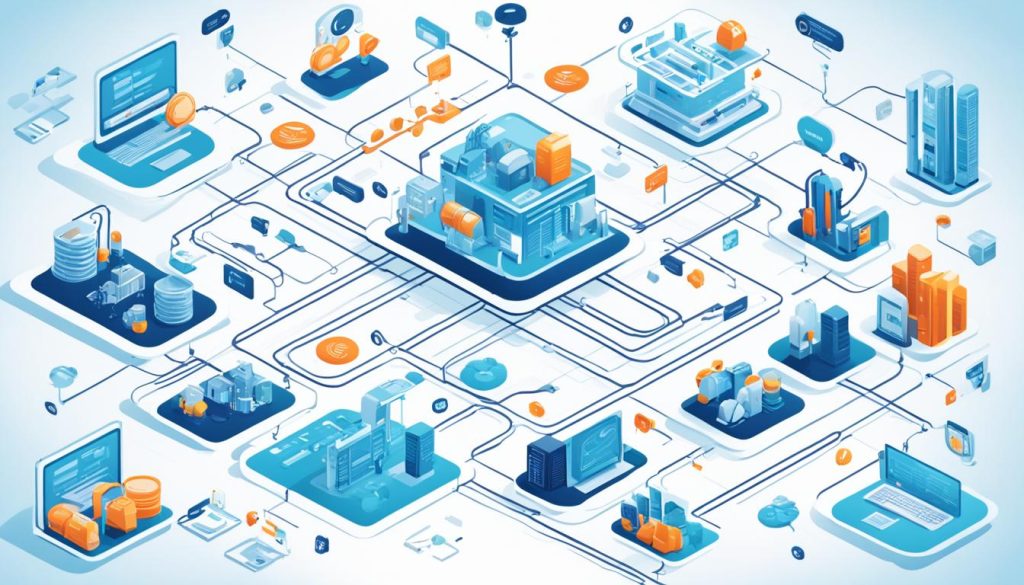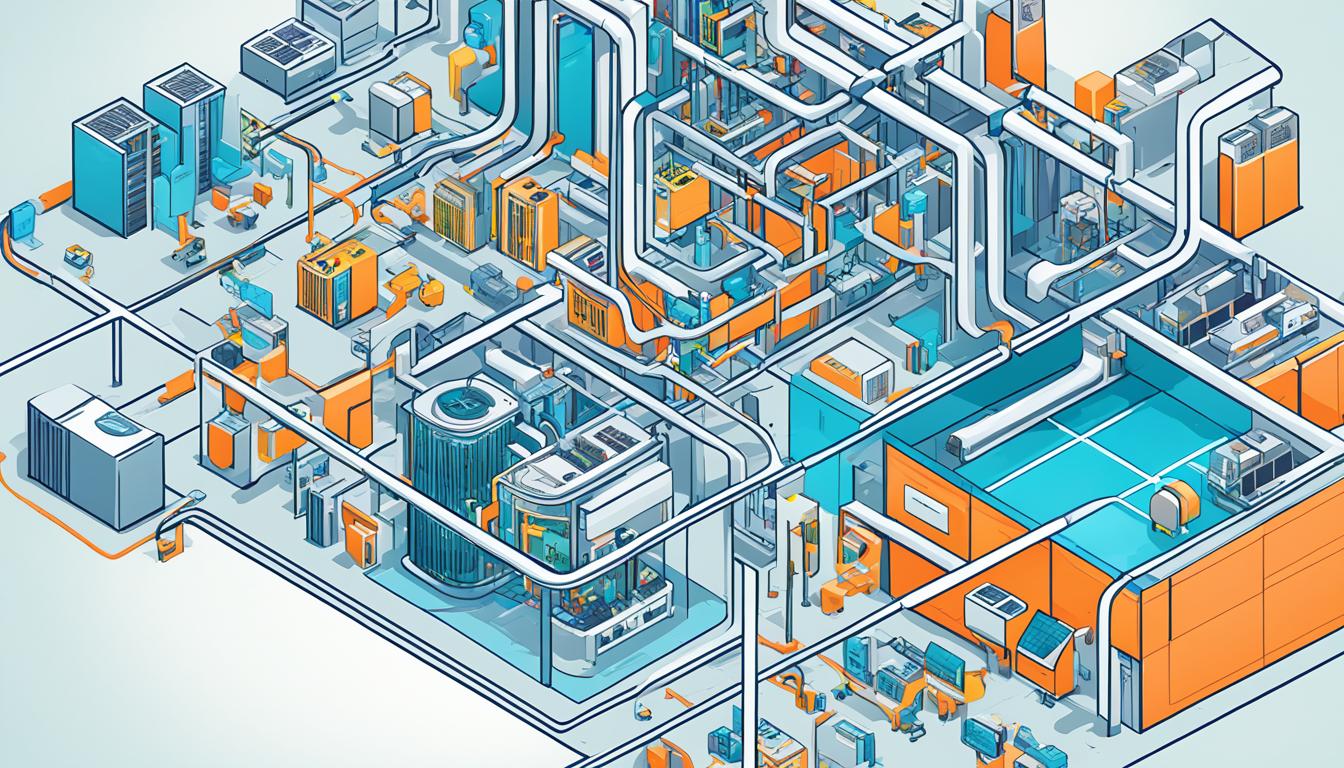Creating a seamless HVAC software ecosystem means bringing your digital tools together. This makes your HVAC business run better and makes customers happier.
Integrating your HVAC software means linking different solutions together. This lets data move smoothly between applications. It makes your operations more efficient and helps you make better decisions.
Linking your HVAC software with CRM and FSM systems makes a strong ecosystem. It gives you a full view of customer info, service requests, and how things run. This leads to better efficiency and a better customer experience with quick updates and fast problem solving.
With these strategic integrations, your HVAC business can tackle big challenges. From managing inventory to talking to customers, a well-connected software ecosystem turns problems into chances for growth and better service.
Understanding the HVAC Industry’s Digital Transformation
The HVAC industry is changing fast, making how businesses work and serve customers new. This change brings both new chances and challenges for HVAC pros.
The evolving landscape of HVAC technology
HVAC systems are getting smarter and more efficient. Thanks to IoT, we can now monitor and control them from afar. Cloud-based solutions give us real-time data. These changes make energy use better and users more comfortable.
Challenges faced by HVAC businesses in the digital era
HVAC companies need to learn new tech fast. They must train staff on digital tools and keep data safe. They also have to merge different software systems for a smooth workflow.
The role of software integration in modernizing HVAC operations
Software integration is crucial for making HVAC work better. With API connectivity, systems talk to each other easily. This makes scheduling, managing inventory, and helping customers better. Working together with vendors through these platforms also helps with supply chain and service.
| Digital Transformation Aspect | Benefits | Challenges |
|---|---|---|
| IoT Enablement | Remote monitoring, Predictive maintenance | Data security, Device compatibility |
| Cloud-based Solutions | Real-time data access, Scalability | Internet dependency, Data migration |
| API Connectivity | Seamless system integration, Improved workflow | Technical expertise required, Maintenance complexity |
By taking on these digital changes, HVAC businesses can work better, save money, and give customers a great experience today.
Key Components of an HVAC Software Ecosystem
A strong HVAC software ecosystem has several key parts that work together. These parts make a single technology platform. They help streamline operations and improve service delivery. Let’s look at the main components that make up a full HVAC software solution.
HVAC service software is at the center of the ecosystem. It handles the whole service process, from first contact with customers to the final job and follow-up. It lets you track work orders, plan maintenance, and manage inventory well.
Customer Relationship Management (CRM) systems are key for keeping strong client relationships. These tools help track customer interactions, manage sales, and keep detailed service histories. By linking CRM with your HVAC service software, you get a smooth flow of information that boosts customer happiness.
Field Service Management (FSM) software makes your on-site work better. It helps with scheduling, dispatching, and gives mobile support for technicians. When it’s linked with your HVAC software, it ensures data updates in real-time between technicians and the office.
Building automation systems are also crucial. They manage and watch various building functions like HVAC, lighting, and security. By linking them with your HVAC software, you can offer services like remote checks and predictive maintenance.
Software interoperability is essential for a unified platform. When all parts talk to each other well, you can use your HVAC software ecosystem fully. This leads to better efficiency and service delivery.
The Importance of HVAC Service Software
HVAC service software is key to modernizing and optimizing HVAC businesses. It helps companies streamline their work, improve customer service, and increase efficiency.
Core functionalities of HVAC service software
HVAC service software has many important features for daily operations:
- Job scheduling and dispatching
- Customer relationship management
- Work order management
- Inventory tracking
- Billing automation
- Reporting and analytics
Benefits of implementing HVAC-specific solutions
Using HVAC service software has many benefits for businesses:
| Benefit | Description |
|---|---|
| Improved operational efficiency | Streamline workflows and reduce manual tasks |
| Enhanced customer satisfaction | Provide faster, more accurate service |
| Better inventory management | Track parts and equipment in real-time |
| Data-driven decision making | Gain insights from comprehensive analytics |
Case studies of successful HVAC service software adoption
Many HVAC companies have seen big improvements with service software. For instance, a mid-sized HVAC firm in Texas increased their daily service calls by 30% after using a full software solution. The software’s HVAC system integration made data exchange smooth between technicians and office staff. This led to quicker response times and happier customers.
Another example is a large commercial HVAC provider that went with a cloud-based service software with API connectivity. This setup allowed for real-time updates across different platforms. It cut billing errors by 25% and scheduling conflicts by 40%.
These stories show how HVAC service software can change business operations and customer service for the better.
Integrating CRM Systems for Enhanced Customer Management
In the HVAC industry, using Customer Relationship Management (CRM) systems is key for better customer care. A single platform that includes CRM software helps keep all customer info in one place. This makes it easier to give personalized service and answer customer questions well.
CRM systems bring big benefits to HVAC companies:
- Improved tracking of sales opportunities
- Enhanced customer retention strategies
- Increased customer satisfaction and loyalty
- Better insights into customer behavior and preferences
CRM systems help make customer experiences smoother. They let data move easily between departments. This means everyone has the latest customer info.
Working with vendors is important for CRM success. Team up with software makers to make sure your CRM fits your HVAC business needs. This teamwork can lead to solutions made just for your industry’s challenges.
| CRM Feature | Benefit for HVAC Business |
|---|---|
| Contact Management | Centralized customer information |
| Service History Tracking | Improved maintenance scheduling |
| Sales Pipeline Management | Enhanced revenue forecasting |
| Customer Communication Tools | Increased customer engagement |
Adding CRM systems to your HVAC tech stack gives you a strong tool for managing customer relationships and growing your business. This integration is a key part of a full, connected tech platform for your HVAC work.
Leveraging Field Service Management (FSM) Software
Field Service Management (FSM) software changes the game for HVAC operations. It makes scheduling technicians more efficient, improves service on-site, and allows for sharing data in real-time. By using FSM solutions, HVAC companies can make their processes smoother and make customers happier.
Streamlining Technician Scheduling and Dispatch
FSM software helps schedule technicians based on their skills, where they are, and when they’re free. This means less time spent traveling and the right expert gets to the job. Customers get quicker service and are more satisfied.
Mobile Capabilities for On-Site Service Excellence
With mobile FSM tools, technicians can see job details, customer info, and inventory on their phones. This gives them everything they need to provide great service. They can also update job status, order parts, and bill customers right away.
Real-Time Data Synchronization and Reporting
FSM software makes sure data flows smoothly between the field and the office. Everyone always has the latest info, which helps with making better decisions. Cloud-based solutions make this even better, letting people access info from anywhere.
| FSM Feature | Benefit | Impact on HVAC Operations |
|---|---|---|
| Smart Scheduling | Optimized technician dispatch | Reduced travel time, increased job completion rate |
| Mobile Access | On-site information availability | Improved service quality, faster problem resolution |
| Real-Time Sync | Up-to-date data across the organization | Enhanced decision-making, improved operational efficiency |
| IoT Enablement | Remote monitoring and diagnostics | Proactive maintenance, reduced downtime |
By using FSM software, HVAC businesses can get the most out of IoT technology, cloud solutions, and smooth data sharing. This tech upgrade means better efficiency, lower costs, and happier customers.
Create a Seamless HVAC Software Ecosystem Through Strategic Integrations
Creating a seamless HVAC software ecosystem is key for today’s businesses. By linking different software parts, you can make operations smoother and improve customer service. This integration lets data move easily between service software, CRM, and field service management systems.
A unified technology platform is essential for this integration. It combines various software solutions into one, making your HVAC business run better. This method boosts efficiency and gives you deeper insights for smarter decisions.

API connectivity is crucial for this ecosystem. It makes sure data moves smoothly between different software, keeping your system connected. This cuts down on data silos and manual entry, saving time and reducing mistakes.
| Integration Component | Benefits | Challenges |
|---|---|---|
| HVAC Service Software | Centralized job management | Data migration from legacy systems |
| CRM Systems | Improved customer insights | Ensuring data privacy compliance |
| Field Service Management | Optimized scheduling and dispatch | Technician adoption of new technology |
| API Connectivity | Seamless data exchange | Maintaining consistent data formats |
To build your HVAC software ecosystem, first look at your current systems and see where you can integrate them. Pick software that has strong API connectivity and fits with what you already have. Roll out the integrations step by step, making sure to test and train users at each phase.
Overcoming Integration Challenges in HVAC Software
Integrating HVAC software systems can be tough. You’ll face many challenges as you try to make everything work together smoothly. Let’s look at the main problems and how to beat them.
Common Integration Obstacles
Problems like data silos, systems that don’t work together, and people not wanting to change can slow you down. These issues can make your HVAC operations less efficient.
- Data silos: Information trapped in separate systems
- Incompatible software: Programs that don’t “talk” to each other
- Employee resistance: Staff reluctant to adopt new technologies
Strategies for Seamless Data Exchange
To make software work together better, focus on open APIs and standard data formats. Working together with vendors is also crucial for a smooth integration of HVAC tools.
- Select software with open APIs for easy connectivity
- Standardize data formats across all platforms
- Prioritize vendor collaboration during integration
- Use a phased approach to implement new systems
- Provide comprehensive training to your staff
Ensuring Cross-Platform Compatibility
It’s important for HVAC software to work together well. Regular testing and updates keep systems in harmony and stop problems before they start.
| Compatibility Factor | Action Item |
|---|---|
| Testing | Conduct thorough integration tests regularly |
| Monitoring | Implement continuous system performance checks |
| Scalability | Choose solutions that adapt to future tech advancements |
| API Connectivity | Ensure robust API connections between systems |
By tackling these challenges, you’ll make your HVAC software system more efficient and unified. Remember, success comes from good planning, ongoing care, and strong partnerships with vendors.
The Role of Cloud-Based Solutions in HVAC Software Integration
Cloud-based solutions are changing the HVAC industry. They bring many benefits for software integration and access. With cloud technology, you don’t need on-site installations anymore. You can access your HVAC systems from anywhere with internet.
Cloud-based HVAC software makes sharing data easy. This helps improve efficiency and decision-making. You can share information between different systems and devices smoothly.

Cloud solutions also make data safer with backups and strong encryption. This means your important information is well-protected. You’ll also save on IT costs and have more reliable systems.
IoT enablement is a big plus of cloud-based HVAC software. It lets you:
- Monitor HVAC systems better
- Control equipment from anywhere
- Manage energy better
- Use predictive maintenance
Cloud solutions grow with your business. They’re scalable, so you can add new features or expand without big hardware costs.
Choosing cloud-based solutions for your HVAC software sets your business up for success. Cloud technology offers seamless data sharing, IoT benefits, and better efficiency. It’s a game-changer for the HVAC industry.
Enhancing Operational Efficiency Through Integrated Analytics
Integrated analytics in HVAC software change how businesses work. They use data from many sources to make processes better, predict maintenance, and improve services. This fits well with the growth of automation and IoT in the field.
Harnessing Data for Business Intelligence
A unified technology platform helps HVAC companies gather and analyze lots of data. This approach leads to smarter decisions and plans. For instance, you can spot trends in energy use, how well equipment works, and what customers like. This makes operations more efficient and customers happier.
Predictive Maintenance and Service Optimization
IoT in HVAC systems lets you watch equipment in real-time. With advanced analytics, you can predict problems before they happen. This means less downtime and longer equipment life. It also saves money and builds trust and loyalty with customers.
Performance Tracking and KPI Management
Automation systems with analytics tools track performance well. You can keep an eye on KPIs like energy use, how fast you respond, and how happy customers are. This helps find areas to get better and makes decisions more informed. It leads to more efficient operations and saves money in your HVAC business.
| KPI | Impact on Efficiency | Measurement Method |
|---|---|---|
| Energy Efficiency | Cost reduction, sustainability | Energy consumption vs. output |
| Response Time | Customer satisfaction, resource allocation | Time from call to resolution |
| Equipment Uptime | Reliability, maintenance efficiency | Operational hours vs. downtime |
Future Trends in HVAC Software Ecosystems
The HVAC industry is on the verge of a big change. Soon, we’ll see smarter and more connected systems. IoT technology is leading this change, making buildings smarter.
Building automation systems are getting better, working well with HVAC controls. This means buildings can control temperature and save energy better.
Cloud-based solutions are changing how we manage HVAC systems. These platforms give us real-time data. This lets us fix problems fast and make systems work better.
| Trend | Impact | Adoption Timeline |
|---|---|---|
| IoT Enablement | Enhanced monitoring and control | 1-3 years |
| AI-Driven Predictive Maintenance | Reduced downtime and repair costs | 2-5 years |
| Advanced Building Automation Systems | Improved energy efficiency | 3-7 years |
| Augmented Reality for Technicians | Faster, more accurate repairs | 5-10 years |
Artificial intelligence and machine learning will change predictive maintenance. These technologies will look at system patterns to predict failures early.
Augmented reality is also coming up. Technicians will use AR glasses to see system data and get repair instructions in real-time. This will make fixing things faster and more accurate.
Conclusion
Creating a seamless HVAC software ecosystem is key to your business’s success today. By linking your HVAC service software, customer management systems, and field service tools, you boost efficiency and customer happiness.
Integrating your HVAC systems means better data sharing across your business. This lets you make smart decisions, improve service, and keep up with maintenance. You’ll see happier customers, more efficient technicians, and a stronger profit.
When dealing with software integration, cloud-based options are flexible and scalable. Use advanced analytics to understand your business better and find ways to get better. Building a strong HVAC software ecosystem puts you ahead in a competitive market.





0 Comments